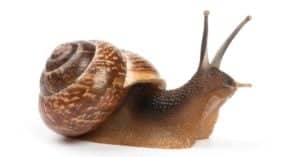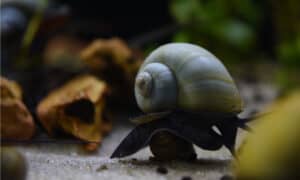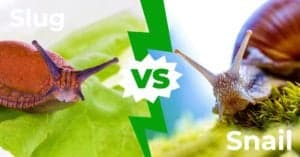The snail is a soft-bodied, slow-moving mollusk, well-protected from predators and threats in its coiled shell. They build up their shells with a substance called calcium carbonate, which spirals outward into whorls as they grow. There are thousands of different species, separated into three basic categories: land snails, freshwater snails, and sea snails. Clad in their extravagant shells, snails can be creatures of exceptional beauty. This article will cover some fascinating details about the 10 most adorable species in the world. Some of the factors that will be considered to rank these cute snails are the complexity and beauty of the shells, the bright and extravagant colors, and otherwise unusual appearances.
#10: Apple Snails
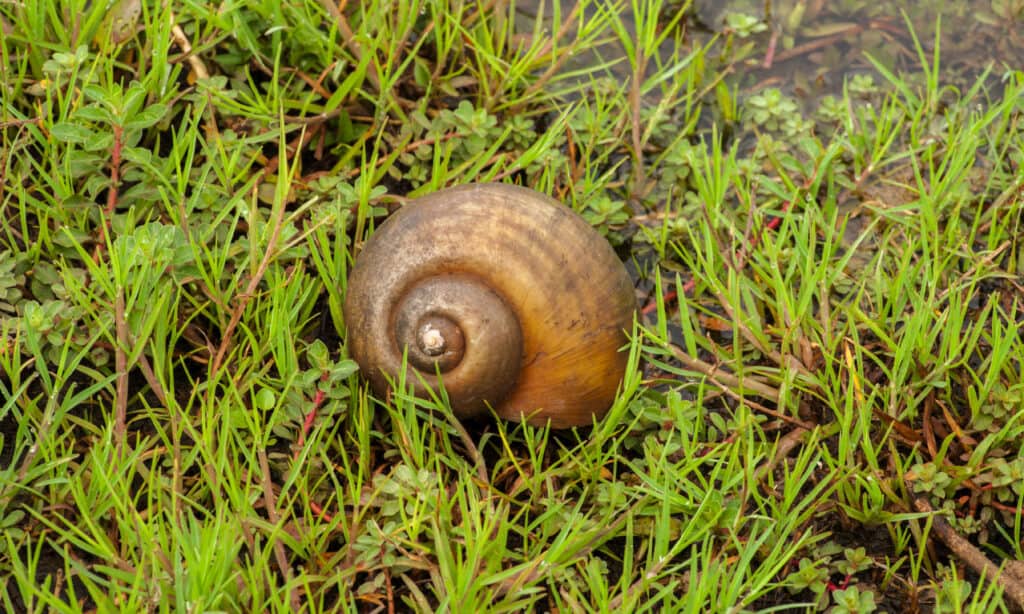
©Asian Images/Shutterstock.com
The apple snail is a family of freshwater gastropods with a diverse geographic range stretching between South America and the southern United States. They are particularly popular aquarium pets for their large size and fascinating appearance. Named for the curved, apple-shaped shell, they come in all kinds of dazzling colors, including blue, purple, pink, and jade, sometimes adorned with stripes as well, and reach up to six inches in size. They are also one of the few animals that can consistently breathe through both lungs and gills. Unfortunately, apple snails can be a bit of a pest as well, because they tend to invade foreign ecosystems and damage local crops, which can starve out other species.
#9: Rabbit Snails
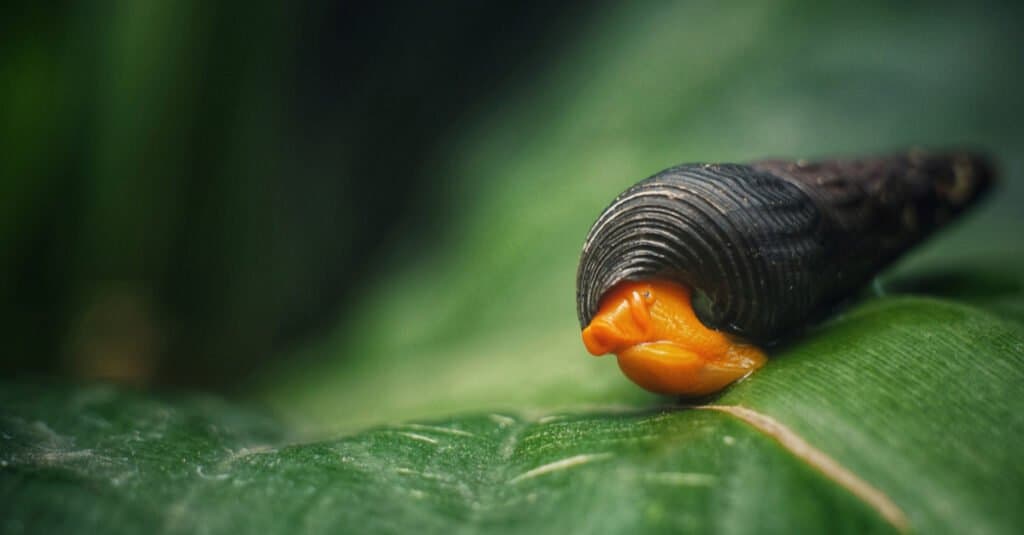
©Yudhy Teguh Ariyantho/Shutterstock.com
These snails go by two different names: either the rabbit snail (because of their large ear-like antennae) or the elephant snail (because of the wrinkled skin and long “trunk”). These tropical species are native to the waters surrounding Indonesia, but they’re also quite popular aquarium animals in the exotic pet trade. They’re fairly small (measuring about two inches long), their skin comes in bright and extravagant colors, and they can be paired with just about any other non-aggressive tank mates. Some species have particularly tall shells that twist upward into seven or eight interesting whorls. Relatively easy to keep in an aquarium, the rabbit snail likes to feed on algae and decaying plant matter. They typically live one to three years at a time.
#8: Domed Land Snails
Sometimes the most beautiful species can be found in the most unexpected places. In 2012, scientists discovered this snail hidden within the depths of Croatia’s Lukina Jama-Trojama cave system, extending down to more than 2,500 feet. This spectacular species has a few things going in its favor to rank it above other cute snails. The first is its incredibly small size. Measuring only two millimeters (that’s 0.08 inches) in height, they are some of the smallest snails in the world. The second is that they possess a highly translucent body and shell, which become a milky white color as they age. This allows you to almost see right through them.
Because they spend their entire lives wrapped in almost complete darkness, they have lost their ability to see in any real detail. It’s believed that their mobility is also limited; instead, they appear to move around with the mud and water of the cave.
#7: Violet Sea Snails

©iStock.com/CatMiche
Clad in a stunning violet-blue or white shell, the violet sea snail spends its entire life tossed about on the surface of the ocean, feeding on the abundant amount of plankton around them. They live almost anywhere with tropical or temperate waters, sometimes even washing up on the beach for people to find. Violet sea snails maintain their buoyancy by drifting along on a bubble raft of their creation. It essentially can secrete mucus from the foot that then traps and hardens the air bubbles around it. This is quite a clever trick and adorable as well.
#6: Red Nerite Snails

©Mark Brandon/Shutterstock.com
Also known as the red racer, this species thrives in brackish or freshwater regions of the Philippines, including mangrove forests, river mouths, and streams; they come on land quite often as well. The name of this species comes from the elaborate shell patterns of alternating red, yellow, and black zigzag bands. One of the most appealing qualities is that no two snails seem to have the exact pattern on their shells.
They’ve been a part of the aquarium trade since 2015 and thrive best when they have a lot of algae and decaying plant matter to feed on, which makes them an excellent tank cleaner. They tend not to disturb fresh plants very much at all. While they do need saltwater to reproduce, red nerites are perfectly fine living in freshwater tanks. The typical lifespan is four to five years.
#5: Amphidromus Snails
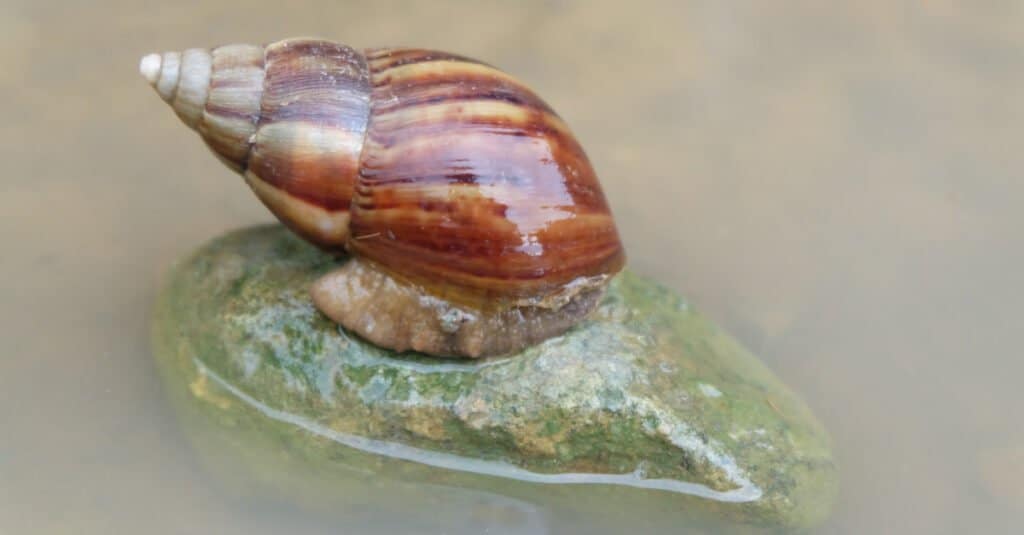
©Needatang/Shutterstock.com
The scientific name of this genus doesn’t exactly roll off the tongue; it generally translates to mean “running on both sides” from Greek. But regardless of how it sounds, the name does accurately refer to the fact that the shell can coil either left or right, which is a very rare phenomenon in the mollusk world, given that snails with opposite coiling shells have trouble reproducing.
The tropical Amphidromus, which hails from southern Asia and Australia, comes in all kinds of bright colors and extravagant shapes. The combination of yellow, purple, brown, green, and blue markings, which vary with the species, almost look like they were painted on by human hand. These snails spend much of their lives in trees, only descending to create more baby snails, but little is otherwise known about how they live.
#4: Sea Butterflies
These spectacular, glimmering, and sometimes even transparent sea snails are found at ocean depths of around a few hundred feet, swept along by the currents. The shells are very fragile, reduced, or even completely absent in some species, which could, unfortunately, make them vulnerable to ocean acidification caused by climate change. They are particularly abundant in the Arctic waters, feeding on many different types of plankton as they flutter around with the flaps of their “wings,” moving vertically in the water column from day to night. In turn, they are very important sources of food for much marine fish. When they get near a beach, their shells can sometimes cause a bit of pain for swimmers, but they are otherwise harmless to people and look very adorable as well.
#3: Candy Cane Snails

©Billy Watkins/Shutterstock.com
This astonishing candy-colored species, with its white shell, measuring up to 2.4 inches long, clad in three to six orange, yellow, red, and purple stripes, is native to the islands of the Caribbean. It spends most of its life living in trees, feeding on lichen, moss, twigs, and small branches with its numerous rows of sharp teeth, and occasionally descends to the ground to lay its eggs in the moist soil. Upon hatching, the baby snails climb back up the trees to spend their lives. Heaps of shells discovered in the modern-day Dominic Republic may indicate that it was once used as a food source by pre-Columbian indigenous people.
#2: Cuban Painted Snails
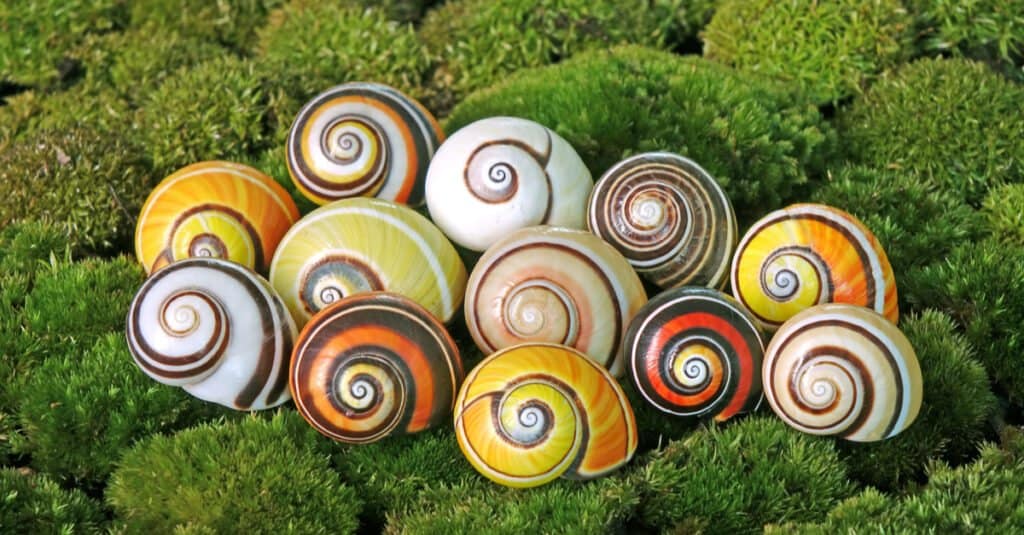
©Mark Brandon/Shutterstock.com
The Caribbean island of Cuba is home to some of the most diverse and beautiful snails on the planet, and the Cuban painted snails are among the most fascinating representations of them. The six species in this genus grow rounded shells that come in a multitude of different colors, from bright yellow to deep purple. Long stripes will usually trace the whorl of the shell to accentuate the swirling appearance.
The snails spend much of their lives in trees, feeding on moss, lichen, and fungi, and then reproduce in the wet season to create more baby snails. During the dry season, it can seal the shell opening with its mucus so it can remain dormant and undisturbed until the rains come again. Unfortunately, these snails are highly endangered by predators, deforestation, invasive species, climate change, and poaching. Their beautiful shells make them sought after for use in jewelry and trinkets.
#1: Jeweled Top Snails
Native to the kelp forests of the North American Pacific coast, stretching between southeast Alaska and Baja California, the jeweled top snail earns the top spot in this ranking of cute snails for its gorgeous conical gold shell, each of the nine whorls traced with violet or magenta stripes. They spend their entire lives suspended from the middle part of the kelp stalk, feeding primarily on algae and simple marine invertebrates; the closely related species of channeled top snail lives above them in the kelp canopy and blue top snails live near the bottom of the stalk. If the top snail gets knocked off, then it will simply climb back up again. When breeding season approaches, top snails deposit eggs in gelatinous ribbons for another snail to fertilize. The baby snails emerge from the eggs in their “adult” form rather than a larval one.
Are Snails Good Pets?
They’re quiet, don’t take up much space, don’t require exercise and are inexpensive to feed – so, yes, they do! Snails like to eat fresh fruits and vegetables – so you can feed them small portions of what you might already buy for your family. Cuttlebones provide the calcium they need. Snails are safe to handle if you wash your hands first, then, while they are still wet, scoop underneath it’s little foot to break the suction. Adorable and affordable – it’s no wonder snails are gaining popularity as pets!
Summary of Cute Snails
| Snail | Native Environment |
|---|---|
| #1. Jeweled Top Snail | Kelp Forests, North American Pacific Coasts |
| #2. Cuban Painted Snails | Cuba |
| #3. Candy Cane Snails | Caribbean Islands |
| #4. Sea Butterflies | Arctic waters |
| #5. Amphidromus Snails | Asia and Australia |
| #6. Red Nerite Snails | Philippines |
| #7. Violet Sea Snails | Anywhere with tropical or temperate waters |
| #8. Domed Land Snails | Croatian caves |
| #9. Rabbit Snails | Indonesia |
| #10. Apple Snails | South America and Southern United States |
Up Next…
- Snail Predators: What Eats Snails? : Snails in the wild face a variety of predators – learn which animals eat snails.
- Snail Lifespan: How Long Do Snails Live?: Thinking of getting a snail for a pet? Learn about the lifespans of snails and more in this informative article!
- Pet Snails: How To Keep Snails Healthy & Happy: If you want your new pet snail to be happy – read this to learn what to do!
- Snail Terrarium: 8 Tips to Make The Best Snail Habitat: Your snail will have it made if you follow these tips to making the best home for your pet!
The photo featured at the top of this post is © Mark Brandon/Shutterstock.com
Thank you for reading! Have some feedback for us? Contact the AZ Animals editorial team.



